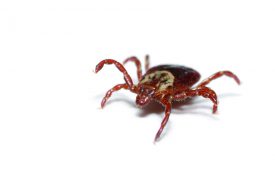 By James L. Occi, graduate student, and Dina M. Fonseca, professor, Department of Entomology
By James L. Occi, graduate student, and Dina M. Fonseca, professor, Department of Entomology
Reprinted from Gardener News, August 2016
How likely is it that you will get Lyme disease while gardening? Assuming you are a New Jersey gardener, a state in the U.S. epicenter of Lyme disease, it turns out it depends on how hospitable your yard is to ticks and the time of the year. So here are the basics and what you can do about it.
Blacklegged ticks, Ixodes scapularis, are the most dangerous tick species in the US and the only ones that transmit the Lyme disease bacterium. In 2013, the most recent year with a full census, the NJ Department of Health reported 2,785 cases of Lyme disease while the Centers for Disease Control and Prevention reported 27,203 for the entire country. Read on if you want to avoid becoming a statistic.
All ticks have three active stages (larva, nymph and adult) and while they only feed once per stage, all stages feed on blood and only blood. Gardeners need to know when each tick stage is active so they can protect themselves. It is important to underscore that ticks take a while to “settle-in” on the host (human or otherwise) and feed for three or more days. Importantly, once they find a host and start feeding, they usually stay on that host. Additionally, the Lyme disease bacterium also takes a while to cross from the tick, where they reside in the gut, to the host the tick is feeding on. This fact underlies the usefulness of “tick checks” that can prevent Lyme disease if performed up to 48 hours after the tick started feeding on you. However, be aware that there are other diseases besides Lyme circulating in NJ blacklegged ticks. Powassan virus can be transmitted after a tick has fed on you for less than 20 minutes. Fortunately, this virus is exceedingly rare.
When should you perform tick checks? That is, where and when do blacklegged ticks find you? Ticks do not jump, skip, hop or fly. They are ambush feeders that wait for a host to come by and only clamp on when in direct contact. The larvae and nymphs are very sensitive to drying out so you would not encounter them on your sun-exposed lawn – it’s too dry – but they would be all over the leaf litter on a forest floor. In New Jersey, the larvae emerge from eggs in August or September but they are not infected with the Lyme bacterium (i.e. larvae are clean). Instead, larvae pick up the Lyme bacterium when they feed on animals such as white-footed mice or chipmunks, which are often infected. When the larvae finish feeding, they fall off the host, hide in the leaf litter and emerge as nymphs in May and June of the following year. Pay attention here: if those nymphs contracted the Lyme bacterium as larvae they are now infected nymphs. Because nymphs are very small and emerge in the spring just as humans begin outdoor activities such as gardening, 95% of Lyme disease cases are due to transmission by nymphs. Gardening season is nymph season and therefore Lyme bacterium transmission season.
After they feed, nymphs drop to the leaf litter, where they digest the blood and eventually develop into an adult (male or female) in the fall of the same year or over the winter. Many adults emerge when deer start their mating season, as deer are an important source of blood for the adult females. The females can transmit the Lyme bacterium to humans but this is rare because they emerge when people are already bundled up against the chillier temperatures. They are also easier to see because they are significantly larger than nymphs. However, it is important to note that if you garden in the fall or winter and do not perform a thorough tick check you may still contract Lyme disease.
In summary, the risk to gardeners of contracting Lyme disease is greatest from May to July when the nymphs are out and to a lesser extent in the fall/winter when the adults are active. If your yard is very sunny, the risk is relatively low compared to yards that are shaded and surrounded by woods. So, (1) keep your garden clear of leaf litter and tall grasses, (2) place wood chips or gravel between lawns and wooded areas to keep ticks away from recreational areas, (3) keep play areas and playground equipment away from vegetation, and (4) discourage deer from invading your yard and bringing ticks with them by planting deer resistant plants and installing deer barriers. When possible, wear long sleeves and long pants and insect repellent when gardening and do not forget tick checks For more information, go to: www.cdc.gov/features/stopticks.
Nurture and enjoy a beautiful garden while protecting yourself and your family.

